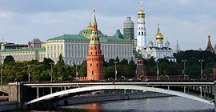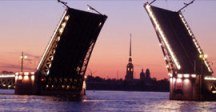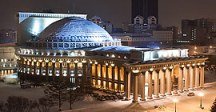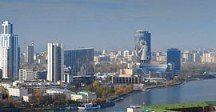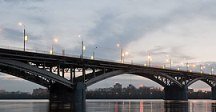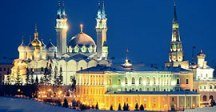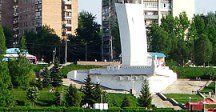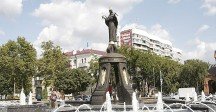Map of Tver
Detailed interactive map of Tver. Map of Tver with streets and numbers of houses. Satellite map of Tver with sights of the city.
The change between the satellite map of Tver and the schematic one is made in the lower left corner of the interactive map.
Tver
The population of the city Tver: 424,969 people (2021)
Date of foundation of Tver: 1135
Tver city phone code: +7 4822
Automobile area code of Tver: 69, 169
Postal code of the city Tver: 17xxxx
Tver is a city in Russia with a population of just over 400 thousand people. It was founded almost 10 centuries ago – in 1135. The city can rightfully be proud of its centuries-old history. The Volga River flows through Tver. According to its architecture, Tver has a lot in common with St. Petersburg, because after the fire of 1763, Tver was rebuilt according to the project of the northern capital.
Of all the beautiful neighborhoods and streets of the city, Trekhsvyatskaya pedestrian Street stands out, which is similar to the Arbat in Moscow. It is considered the most cozy place in Tver, where cafes and souvenir shops are located. Citizens also like to take walks along the Razin embankment, which is located in the very center of the city. There you can admire the carved old houses and a beautiful view of the Volga River.
What to see in Tver
Alexander Nevsky Cathedral on the forecourt. Work on the construction of the Alexander Nevsky Cathedral began in 2010 with funds raised from the public. Earlier, a church was built in this area outside the railway station by order of Emperor Alexander II in 1893. In 1921, this church was closed and subsequently used as a grocery store.
The monument to Alexander Pushkin on the Mikhail Yaroslavich Embankment was opened in 1974 and is the work of the famous sculptor Oleg Komov.
Ascension Cathedral on Sovetskaya Street. Previously, there was a wooden church dedicated to the Ascension of Christ, until it was destroyed in Troubled Times, later it was rebuilt. In 1751, work began on replacing the stone, which was completed in 1760. Three years later, the new cathedral was damaged by fire, but was completely rebuilt in 1768. The bell tower was added in 1805.
Tver City Gardens are located between the Volga and Sovetskaya Street, where the Tver Kremlin once stood. The gardens were first opened in 1931, when three pre-existing parks were transformed into one large nine-hectare urban park. In addition to trees, lawns and flowers, there are several monuments, cafes and attractions.
Monument to the city of Military Glory. In 2010, Tver was awarded the title of the City of Military Glory, and in 2011, to commemorate this, a monument was unveiled on Pushkin Square. This is a standard monument of the city of Military Glory with a granite obelisk with a Russian double-headed eagle. The obelisk is surrounded by four pedestals with engravings of the Battle of Bortenevo, battles of the Time of Troubles, the Napoleonic War and World War II.
Mikhail Krug was born in Tver in 1962 and later became a famous Russian chanson singer. The circle was especially popular in the late 1980s and 1990s.
The monument to Karl Marx in front of 16 Sovetskaya Street, installed in the walls of the city garden, is one of the oldest monuments to Karl Marx in Russia, which was opened in 1919.
Monument to Mikhail Kalinin on Cathedral Square. Kalinin was born in Tver province in 1875. The city of Tver was called Kalinin in his honor from 1931 to 1990.
Monument to Mikhail Saltykov-Shchedrin in the gardens of Tverskaya Square. Mikhail Saltykov-Shchedrin was a famous writer and satirist who was born in Tver province in 1826, and also served as vice-governor of Tver for some time.
The Mikhail Saltykov-Shchedrin Museum on Rybatskaya Street was opened in 1976 to mark the 150th anniversary of Saltykov-Shchedrin's birth and tells in detail about his life and work. Some of the displays consist of decorative panels based on the works of Saltykov-Shchedrin.
Monument to Prince Mikhail Yaroslavich on Sovetskaya Square. Mikhail Yaroslavich ruled in Tver from about 1282 to 1318 and was also the Grand Duke of Vladimir. This statue was unveiled in 2008.
The Tver Cathedral Mosque is located at the end of Sovetskaya Street. A permit for the construction of the mosque was issued in 1905. It consists of a cubic building with a minaret.
The Tver Imperial Palace of Travelers (Tver Region Art Gallery) on Sovetskaya Street was built in order to serve as a palace for the imperial family to stay during the journey from St. Petersburg to Moscow. It was built between 1764 and 1766 in a classical style with Baroque elements. At the beginning of the 19th century, the palace was reconstructed by the famous Italian architect Carlo Rossi. Around this time, it was used as the residence of Grand Duchess Ekaterina Pavlovna.
The Tver Regional Museum of Local Lore on Sovetskaya Street was founded in 1866 and is now located in the former school building of the mid-19th century. It includes expositions dedicated to the flora and fauna of the Tver region, geographical history, ancient Tver and Tver during the Russian Empire, during the Napoleonic War and during World War II.
The main pedestrian street of Tver is Trekhsvyatskaya Street, which runs from the embankment of Stepan Razin through Lenin Square and down to Tchaikovsky Avenue. The street was created in the middle of the 18th century after a large fire destroyed most of the city center. From 1919 to 1991, the street was known as Moses Ugritsky Street.
Monument to Afanasy Nikitin. Afanasy Nikitin was a 15th-century traveler from Tver who traveled through the Caucasus, Persia and India. His statue was unveiled on the left bank of the Volga in 1955 and has since become one of the symbols of Tver. The monument includes a four-meter bronze statue of a traveler standing on a granite pedestal and a base decorated with boats.
The Museum of Everyday Life in Tver was opened in 1970 in a 17th-century merchant's house. The museum is dedicated to the daily life of residents of Tver province and the decorative and applied arts created by the urban craft and peasant class.
The Old Bridge or the Old Volga Bridge has become one of the symbols of Tver. The bridge is about 215 meters long and connects the Central District of Tver with the Zavolzhsky district on the other side of the Volga River.
The oldest surviving church in Tver is the Church of the Holy Trinity, which is often called the White Trinity Church due to the fact that it is built of white stone. The construction of the church was completed in 1564 with the blessing of Tsar Ivan the Terrible. In shape, the church is a structure with seven domes and a bell tower. The relics of St. Macarius of Kalyazin are kept in the church.
Monument to Ivan Krylov in front of Victory Square. Ivan Krylov was a poet, playwright and one of the most famous authors of fables in Russia, which were often satirical in nature. He was born in 1769 and spent part of his childhood in Tver. This monument was opened in 1959 in a small park opposite Victory Square. The monument depicts Krylov standing on a pedestal decorated with reliefs of scenes from his fables.
The memorial complex on Victory Square was opened in 1970, and its main feature is a 48-meter obelisk, at the base of which the eternal flame burns.
Sights of Tver
Imperial Travel Palace, Regional Art Gallery, City Garden, Colored Musical Fountain, Museum of Local Lore, Tver Museum of Horrors, Saltykov-Shchedrin Museum, Kozl Museum, Afanasy Nikitin Embankment, Stepan Razin Embankment, Cathedral of the Ascension of the Lord, White Trinity Church, Monument to Mikhail Krug, Tverskoy River Station, Voroshilov Riflemen House, The Monastery of the Nativity of Christ, the Church of the Sorrows, the Botanical Garden, the Stele "City of Military Glory", the Tver Academic Regional Philharmonic, the Tver Regional Academic Drama Theater.
The largest cities in Russia:
2024 © Russia-Karta.ru
